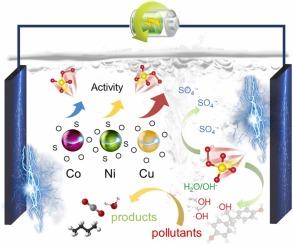电场调节下选择性生成羟基和硫酸根自由基以降解微污染物:机理与结构-活性关系
IF 12.2
1区 环境科学与生态学
Q1 ENGINEERING, ENVIRONMENTAL
引用次数: 0
摘要
过氧单硫酸盐(PMS)活化会产生硫酸根自由基(SO4--)和羟基自由基(-OH)等强效活性氧(ROS),它们在有机污染物降解过程中发挥着关键作用。然而,控制这些自由基的生成仍然具有挑战性。本研究合成了各种掺杂金属(Co、Ni 和 Cu)的氮碳化合物(NCs),并探讨了它们在电场调节下活化 PMS 的性能,以调节 ROS 的产生,从而选择性地降解污染物。研究选择了易降解化合物双酚 A(BPA)和难降解污染物布洛芬(IBU)作为模型污染物来评估降解效率。在没有电场的情况下,所有催化剂对双酚 A 的去除率都超过了 95%,但施加电场后,双酚 A 的降解速度明显加快,在 3 分钟内就能完全去除。相比之下,IBU 的降解随催化剂的使用和电场强度的不同而有显著差异,其中 Cu-NC 的性能最高,降解率提高了 3.78 倍。机理研究表明,电场改变了催化剂表面的电子密度,在 Co-NC 系统中,ROS 的产生从 SO4 转变为 -OH。这些发现可以为电场调节下的 PMS 活化提供有价值的见解,为通过控制 ROS 生成来提高微污染物去除率提供了一种新策略。本文章由计算机程序翻译,如有差异,请以英文原文为准。

Selective generation of hydroxyl and sulfate radicals under electric field regulation for micropollutants degradation: Mechanism and structure-activity relationship
Peroxymonosulfate (PMS) activation generates potent reactive oxygen species (ROS) such as sulfate radical (SO4·–) and hydroxyl radical (·OH), which play a key role in organic pollutant degradation. However, controlling the generation of these free radicals remains challenging. In this study, various metal (Co, Ni, and Cu)-doped nitrogen carbon compounds (NCs) were synthesized, and their performance in PMS activation under electric field regulation was explored to modulate ROS production for selective pollutant degradation. Bisphenol A (BPA), a readily degradable compound, and ibuprofen (IBU), a recalcitrant pollutant, were chosen as model pollutants to assess degradation efficiency. All catalysts achieved over 95 % BPA removal without the electric field, but the application of an electric field significantly accelerated BPA degradation, achieving complete removal within 3 min. In contrast, IBU degradation showed significant variation depending on the catalyst used and the electric field intensity, with Cu-NC demonstrating the highest performance, enhancing the degradation rate by 3.78-fold. Mechanistic studies revealed that the electric field altered the electron density on the catalyst surface, shifting ROS production from SO4·– to·OH in Co-NC systems. The findings could provide valuable insights into PMS activation under electric field regulation, offering a novel strategy for enhancing micropollutant removal through controlled ROS generation.
求助全文
通过发布文献求助,成功后即可免费获取论文全文。
去求助
来源期刊

Journal of Hazardous Materials
工程技术-工程:环境
CiteScore
25.40
自引率
5.90%
发文量
3059
审稿时长
58 days
期刊介绍:
The Journal of Hazardous Materials serves as a global platform for promoting cutting-edge research in the field of Environmental Science and Engineering. Our publication features a wide range of articles, including full-length research papers, review articles, and perspectives, with the aim of enhancing our understanding of the dangers and risks associated with various materials concerning public health and the environment. It is important to note that the term "environmental contaminants" refers specifically to substances that pose hazardous effects through contamination, while excluding those that do not have such impacts on the environment or human health. Moreover, we emphasize the distinction between wastes and hazardous materials in order to provide further clarity on the scope of the journal. We have a keen interest in exploring specific compounds and microbial agents that have adverse effects on the environment.
 求助内容:
求助内容: 应助结果提醒方式:
应助结果提醒方式:


